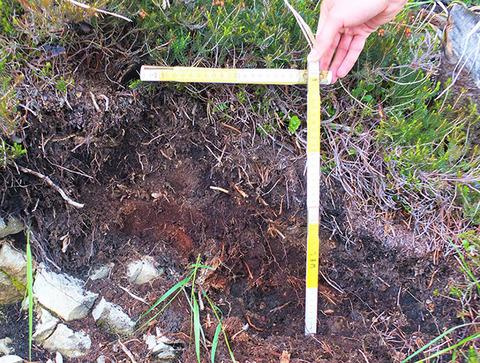当前位置:
X-MOL 学术
›
Appl. Veg. Sci.
›
论文详情
Our official English website, www.x-mol.net, welcomes your
feedback! (Note: you will need to create a separate account there.)
Plant indicators for Folic Histosols in mountain forests of the Calcareous Alps
Applied Vegetation Science ( IF 2.0 ) Pub Date : 2019-12-15 , DOI: 10.1111/avsc.12470 Michelangelo Olleck 1 , Birgit Reger 1 , Jörg Ewald 1, 2
Applied Vegetation Science ( IF 2.0 ) Pub Date : 2019-12-15 , DOI: 10.1111/avsc.12470 Michelangelo Olleck 1 , Birgit Reger 1 , Jörg Ewald 1, 2
Affiliation

|
QUESTIONS: Although thick forest floors overlying unweathered bedrock are important resources for mountain forests' functioning, their actual distribution is poorly known and difficult to delimit in the field. We therefore asked: (a) What is the specific composition of vegetation growing on Folic Histosols; (b) can indicator plants be used to detect Folic Histosols in mountain forests; (c) what do functional traits of plant indicators tell about the ecological properties of Folic Histosols? LOCATION: Northern Calcareous Alps, south Germany. METHODS: Based on representative stratified sampling of joint vegetation plots and soil profile descriptions, we estimated the frequency and thickness of Folic Histosols, determined the proportion of compositional variation specifically attributable to forest floor thickness using ordination, applied Indicator Species Analysis and searched for typical traits and ecological requirements of indicator species. RESULTS: The co‐existence of acidophilic and calciphytic plants is typical for the tessellated occurrence and the successional origin of Folic Histosols. In the study region, the detection of Folic Histosols on pure limestone or dolomite by ground vegetation works very well. Particularly acidophilic plants are suitable indicators for thick forest floors. The indicator value of bryophytes and Ericaceae for Folic Histosols is likely related to the colonization of rotten wood. Folic Histosol indicator species are widely spread in the allocation to sociology group, which ranges from open landscapes to dark forests and reflects successional origin. CONCLUSIONS: In mountain forests on carbonate bedrock, thick humus layers often occur next to bare rock. This tessellated structure can also be detected in the ground vegetation, where acidophilic and calciphytic plants occur side by side. Thick Folic Histosols in late successional forests are dominated by acidophilic plants colonizing rotten wood. Thus, the detection of Folic Histosols by understorey species is an easy and cost‐effective possibility and one key to protect these vulnerable forest sites.
中文翻译:

钙质阿尔卑斯山山林中叶组织溶胶的植物指标
问题:虽然覆盖在未风化基岩上的厚林地层是山地森林功能的重要资源,但它们的实际分布却鲜为人知,并且难以在野外划定。因此,我们问:(a) 生长在叶组织溶胶上的植被的具体组成是什么;(b) 指示植物是否可用于检测山林中的叶酸组织溶胶;(c) 植物指标的功能特征对叶酸组织溶胶的生态特性有何影响?地点:德国南部的北钙质阿尔卑斯山。方法:基于联合植被地块的代表性分层抽样和土壤剖面描述,我们估计了叶组织溶胶的频率和厚度,使用排序确定了特别归因于森林地面厚度的成分变化比例,应用指示种分析,寻找指示种的典型性状和生态要求。结果:嗜酸和钙生植物共存是叶组织溶胶的镶嵌分布和演替起源的典型特征。在研究区,地面植被检测纯石灰岩或白云岩上的叶酸组织溶胶效果很好。特别是嗜酸植物是茂密森林地面的合适指示剂。苔藓植物和杜鹃花科对叶组织溶胶的指示值很可能与腐木的定植有关。Folic Histosol 指示物种广泛分布在社会学组的分配中,其范围从开阔的景观到黑暗的森林,并反映了演替起源。结论:在碳酸盐岩基岩上的山林中,厚厚的腐殖质层经常出现在裸露的岩石旁边。这种镶嵌结构也可以在地面植被中检测到,在那里,嗜酸植物和钙生植物并存。晚期演替森林中的厚叶组织溶胶以定植腐烂木材的嗜酸植物为主。因此,通过林下物种检测叶酸组织溶胶是一种简单且具有成本效益的可能性,也是保护这些脆弱林地的关键。
更新日期:2019-12-15
中文翻译:

钙质阿尔卑斯山山林中叶组织溶胶的植物指标
问题:虽然覆盖在未风化基岩上的厚林地层是山地森林功能的重要资源,但它们的实际分布却鲜为人知,并且难以在野外划定。因此,我们问:(a) 生长在叶组织溶胶上的植被的具体组成是什么;(b) 指示植物是否可用于检测山林中的叶酸组织溶胶;(c) 植物指标的功能特征对叶酸组织溶胶的生态特性有何影响?地点:德国南部的北钙质阿尔卑斯山。方法:基于联合植被地块的代表性分层抽样和土壤剖面描述,我们估计了叶组织溶胶的频率和厚度,使用排序确定了特别归因于森林地面厚度的成分变化比例,应用指示种分析,寻找指示种的典型性状和生态要求。结果:嗜酸和钙生植物共存是叶组织溶胶的镶嵌分布和演替起源的典型特征。在研究区,地面植被检测纯石灰岩或白云岩上的叶酸组织溶胶效果很好。特别是嗜酸植物是茂密森林地面的合适指示剂。苔藓植物和杜鹃花科对叶组织溶胶的指示值很可能与腐木的定植有关。Folic Histosol 指示物种广泛分布在社会学组的分配中,其范围从开阔的景观到黑暗的森林,并反映了演替起源。结论:在碳酸盐岩基岩上的山林中,厚厚的腐殖质层经常出现在裸露的岩石旁边。这种镶嵌结构也可以在地面植被中检测到,在那里,嗜酸植物和钙生植物并存。晚期演替森林中的厚叶组织溶胶以定植腐烂木材的嗜酸植物为主。因此,通过林下物种检测叶酸组织溶胶是一种简单且具有成本效益的可能性,也是保护这些脆弱林地的关键。











































 京公网安备 11010802027423号
京公网安备 11010802027423号